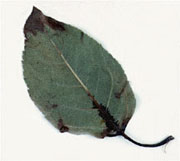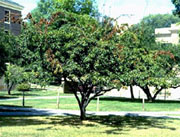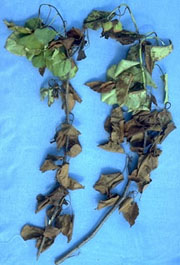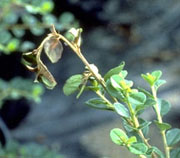Fire blight, caused by the bacterium Erwinia amylovora, is a serious disease of many ornamental species in the Rosaceae family. Certain varieties of apple, flowering crabapple, pear, pyracantha, and quince are highly susceptible. Other plants, such as hawthorn, Japanese quince, mountain ash, rose, cotoneaster, spirea, loquat, and amelanchier, may occasionally also be damaged.
 Fig. 1. Blackening of petiole and adjacent tissue on apple leaf. (Photo by M. A. Hansen)  Fig. 2. Dieback of scattered branches on crabapple. (Photo by M. A. Hansen)  Fig. 3. Fire blight on Bradford pear. (Photo by M. A. Hansen)  Fig.4. Shepherd's crook on cotoneaster. (Photo by R. C. Lambe) |
Symptoms
Blossoms, young fruits, small twigs, leaves and water sprouts are susceptible to infection. Blossoms and leaves wilt suddenly, turn dark brown to black, shrivel, and die, but usually remain attached to the plant. Leaves are often infected through the petiole and, on some plants, blackening of the petiole and adjacent tissue can be seen before the whole leaf dies (Fig. 1). Infected fruit becomes leathery in appearance. Cankers on limbs are characteristically shrunken and dark brown to purplish in color. Dark streaking in the wood often extends several inches beyond any surface discoloration. Secondary infections start in the small twigs, progress down the stem, and may eventually involve whole branches (Fig. 2). Severely blighted plants appear to have been scorched by fire (Fig. 3). A characteristic symptom of fire blight is the bending of the blighted terminal, which resembles a shepherd's crook (Fig. 4).
Disease Cycle
The bacteria overwinter in cankers and begin multiplying in the spring. Milky white to cream-colored bacterial slime, containing millions of bacteria, may ooze from the cankers in the spring. The bacteria grow most rapidly at 24°-29°C (75°-84°F). They are disseminated by wind-blown rain, certain insects, and pruning tools. Primary infections usually occur through the flowers at bloom, but bacteria quickly spread to twigs and leaves. The bacteria often invade wounds, and infection can be especially severe after hail storms. By mid to late summer bacterial multiplication slows as cankers form. As the bark tissues die, so do the bacteria, but bacteria may remain active at canker margins until the fall.
Control
Cultural Control
During the late summer when bacterial growth slows, all infected twigs and branches should be pruned out and burned or buried. Because the bacteria are usually found somewhat in advance of the obviously diseased tissue, the cut should be made through healthy wood 6 to 8 inches below the point of visible infection. Cankered areas on large branches and trunks should be pruned out during the dormant season. Pruning tools should be sterilized frequently with rubbing alcohol or dilute household bleach (1 part bleach to 9 parts water) during this operation to prevent introducing the bacteria to new wood.
Fire blight is worse on succulent tissues. Avoid excessive use of nitrogenous fertilizers and excessive pruning, both of which promote succulent growth. Remove water sprouts that form on susceptible tree species as they appear. Water sprouts are very susceptible to infection and can provide direct access of the bacteria to the trunk.
Chemical Control
Chemical control is not generally recommended for fire blight in home landscape situations. In commercial operations, chemical control consists of spraying the antibiotic, streptomycin sulfate, (e.g. Agri-Strep) during the bloom period. Sprays applied after that time are not effective. Refer to the current Virginia Pest Management Guide for Horticultural and Forest Crops (VCE Publication 456-017), http://www.ext.vt.edu/pubs/pmg/, for details on rates and timing of application.
Resistance
Varying levels of resistance to fire blight have been found among cultivars of some common landscape ornamentals (Tables 1-2). Resistant cultivars should be considered for new plantings.
| Table 1. Crabapple cultivars with resistance to fire blight and other major crabapple diseases (scab and powdery mildew) | ||
| Adams* Adirondack Baskatong Candied Apple Centennial Dolgo Donald Wyman Henningi | | Jewelberry Louisa Molten Lava Prairie Fire Professor Sprenger Robinson Selkirk *Adams has poor resistance to Japanese beetles. |
| Table 2. Tolerant or resistant ornamental pear cultivars | ||
| P. betulaefolia 'Dancer' P. calleryana 'Alfred' P. calleryana 'Bradford' | | P. calleryana 'Capitol' P. calleryana 'Cleveland Select' P. calleryana 'Fauriei' |
Author: Mary Ann Hansen, Extension Plant Pathologist, Department of Plant Pathology, Physiology and Weed Science, Virginia Tech
No comments:
Post a Comment